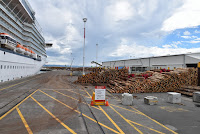
Napier is a seaport located in Hawke's Bay on the eastern coast of the north island. The city was rebuilt in art deco style after an earthquake in 1931. The port is a major container terminal with a constant flow of logging trucks with pine logs destined for Japan.
We arrived on the first day of the Art Deco Festival. The streets were filled with antique cars and people in period costumes to greet us.

 The rubble from the earthquake was used to extend the land out along the waterfront and covered with grass. Today there is a sunken garden, mini-putt golf course, playground, skateboard park and beautiful parkland along the edge of the harbour.
The rubble from the earthquake was used to extend the land out along the waterfront and covered with grass. Today there is a sunken garden, mini-putt golf course, playground, skateboard park and beautiful parkland along the edge of the harbour. We walked to the National Aquarium of New Zealand along the walkway lined with Norfolk Pines. We saw "Little Penguins" who had been rescued and searched for the elusive Kiwi but still only found a stuffed one.
The down town area was ideal for some souvenir shopping (grandchildren take note). Tomorrow is a day at sea as we make our way to the northern tip of the north island.











